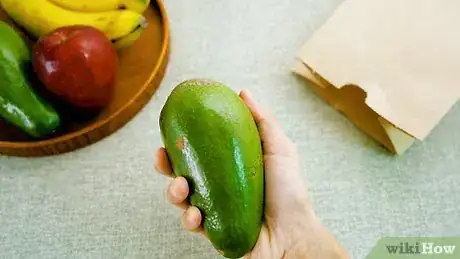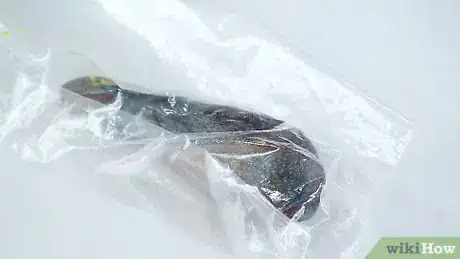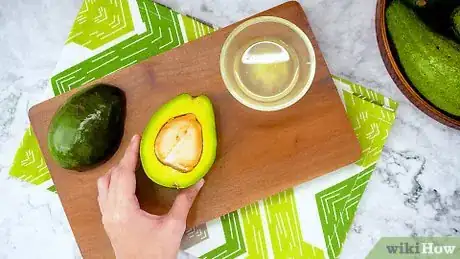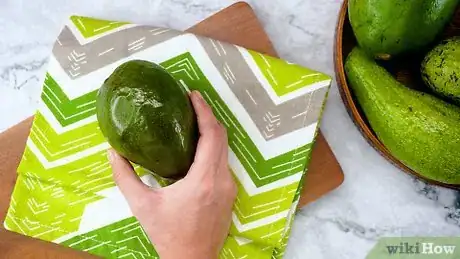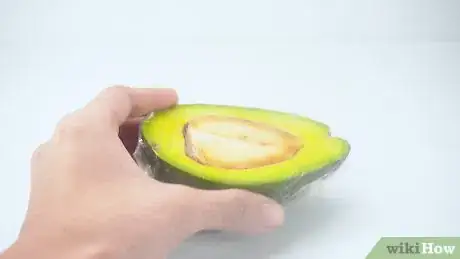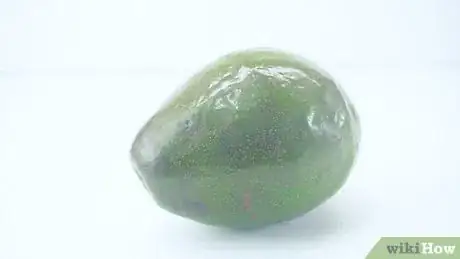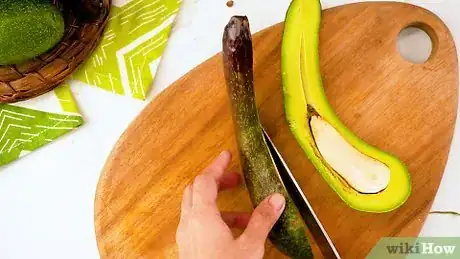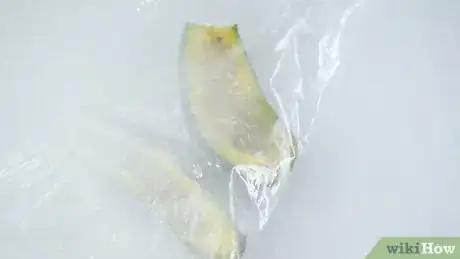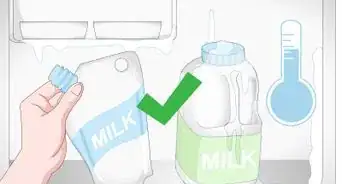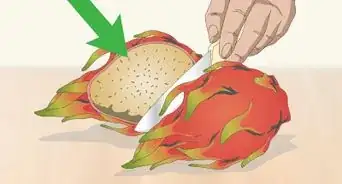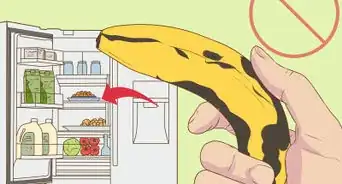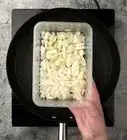This article was co-authored by Ollie George Cigliano and by wikiHow staff writer, Eric McClure. Ollie George Cigliano is a Private Chef, Food Educator, and Owner of Ollie George Cooks, based in Long Beach, California. With over 20 years of experience, she specializes in utilizing fresh, fun ingredients and mixing traditional and innovative cooking techniques. Ollie George holds a BA in Comparative Literature from The University of California, Berkeley, and a Nutrition and Healthy Living Certificate from eCornell University.
There are 7 references cited in this article, which can be found at the bottom of the page.
wikiHow marks an article as reader-approved once it receives enough positive feedback. In this case, several readers have written to tell us that this article was helpful to them, earning it our reader-approved status.
This article has been viewed 227,840 times.
Avocados are fairly delicate and will brown quite quickly after they’ve turned ripe, especially if they’ve been cut. Storing your avocado properly will ensure that the fruit stays edible and delicious for the longest possible time. To store an unripe avocado, place it in a brown bag and fold the top of the bag over. Leave the bag on your countertop for 3-5 days until the fruit is edible. Store a ripe avocado or a sliced avocado in the refrigerator using plastic wrap or a plastic bag. Once an avocado has ripened, consume it within 1-2 days to ensure that it stays tasty and delicious.
Steps
Storing an Unripe Avocado
-
1Feel for bumpy skin to verify your avocado’s ripeness. You can tell if your avocado is ripe or not by touching and looking at it. Ripe avocados have a dark green skin and bumpy texture. Unripe avocados are a brighter shade of green and have a smoother skin. Inspect the look and feel of the avocado. Then, try gently squeezing it. If the fruit has a little give and isn’t firm, it’s ripe. Unripe avocados will be hard and difficult to squeeze.[1]
- Once an avocado is ripe, it should be consumed within 1-2 days.
- A ripe avocado will feel similar to a ripe orange when you squeeze it. An unripe avocado may resemble a baseball or apple in terms of firmness.
Tip: Squeezing an avocado can bruise it. If you want to minimize the impact of bruising while you’re testing it, press your avocado near the stem.
-
2Place the avocado in a brown paper bag to ripen it. Get a brown paper bag from your local grocery or corner store. Empty the bag and place the avocado at the bottom. Fold the top of the bag over itself to partially seal the bag. As the fruit ripens, a chemical called ethylene is released. The bag will trap it inside, which will encourage the fruit to ripen more quickly.[2]
- The temperature of your home should be 65–75 °F (18–24 °C) if you want your avocado to ripen evenly.
- If you aren’t in a rush and don’t mind waiting for a while, you can simply leave it out on the counter. It will take 2-3 days for an avocado to ripen in a paper bag. Without the paper bag, it will take 3-5 days for the avocado to ripen.
- Some people claim that adding an apple or banana to the bag will speed up the ripening process. There isn’t much evidence that this works, though.[3]
Advertisement -
3Check the avocado every day until it becomes ripe. Once you’ve bagged the avocado, wait at least 24 hours before taking it out. When you take it out, inspect the skin, color, and firmness to see if it’s ripe. Use your avocado within 1-2 days of ripening.[4]
- If you want to improve the flavor of you avocado, fill the brown bag with flour before burying your avocado. This will result in a richer, softer avocado.[5]
Refrigerating a Ripe Avocado
-
1Put your avocado in an airtight plastic bag. Get a plastic sandwich or food storage bag with a sealable zipper. Take your whole avocado and set it inside the plastic bag. Storing your ripe avocado in the refrigerator will slow down the browning process. You can store an uncut, ripe avocado in the refrigerator for 3-5 days before it starts to go bad.[6]
- You may experience some browning when you cut it, regardless of how long the fruit has been in the fridge.
- You can use a vacuum-seal food bag instead of a sealable plastic bag if you prefer.
- Signs that your avocado may have gone bad include wrinkling of the skin, it caves in easily to the touch and it feels light to hold.
Tip: You don’t need to store the avocado in a plastic bag, but the bag will ensure that other food smells don’t penetrate your fruit.
-
2Squeeze the air out before sealing the bag’s zipper. With your avocado in the bag, close the zipper 3/4 of the way. Then, starting out at the bottom of the bag, squeeze the air out of the bag. Put your palms or fingers on each side of the bag and slowly push the air out towards the open section of the zipper. Once you’re removed almost all of the air, seal the bag.[7]
- You can wrap the avocado in plastic wrap if you don’t have a plastic bag available.
-
3Place the avocado in the refrigerator to store it for 3-5 days. Set your plastic bag in the refrigerator in an unoccupied drawer or on an empty shelf. Leave your avocado in the refrigerator for 3-5 days. If your avocado is really soft when you put it in the fridge, it may start to go bad after 1-2 days.[8]
- When you take your avocado out, immediately cut it the same way that you normally would. If you let it return to room temperature, it may get a little mushy.
Packaging a Cut Avocado
-
1Set your sliced avocado out on a cutting board or paper towel. If you’ve already cut an avocado and don’t want to finish it, store the avocado in the refrigerator. You can do this if the avocado is ripe or unripe. If your avocado is already ripe when you’ve cut it, you can store it in the refrigerator for 2-3 days. If the avocado isn’t ripe yet and you want to save it for later, it will be ripen in 3-4 days.[9]
- It is not ideal to store an avocado that has been cut outside of the fridge. The fruit will develop a mushy texture that many people find unpleasant.
Tip: Taking the pit out or leaving it in won’t affect the flavor of your avocado. However, removing it will expose more of the fruit. This will expose more of the skin to oxygen, which causes browning. On the other hand, the texture of your fruit will be more uniform if more of the avocado is exposed. It’s totally up to you.
-
2Brush any exposed surfaces of the fruit with lemon juice. Fill a small bowl with 3–5 teaspoons (15–25 mL) of fresh lemon juice. Take a 1–3 in (2.5–7.6 cm) pastry brush and dip it in your lemon juice. Then, brush each of the exposed sections of your fruit with the lemon juice, reloading the brush as needed.[10]
- The lemon juice will preserve the surface of the avocado to keep it from browning.
- You can use orange juice, vinegar, or tomato juice if you prefer, but these options will change the flavor of the avocado more dramatically.
-
3Put your avocado back into its original shape if you can. If you cut your avocado into halves or quarters, place the pieces back together to replicate the original shape of the avocado. Squeeze the pieces lightly together before you wrap it to minimize the avocado’s exposure to the air.[11]
- If your avocado is cut up into different pieces or you’ve already discarded part of it, skip this step. Wrap your individual slices individually to preserve them.
-
4Wrap the avocado in plastic wrap to seal it. Pull a 12–18 in (30–46 cm) sheet of plastic wrap out of the roll. Place your avocado near an edge of the wrap. Then, fold the edge of the plastic over the avocado. Turn the avocado around in the plastic wrap while pulling the plastic tight and fold the edges over one another to seal your fruit.[12]
- You can use a vacuum bag designed for storing food if you prefer.
-
5Store your fruit in the refrigerator for 3-5 days. Place your fruit in the refrigerator in an unoccupied area. The fruit drawer is ideal if you’re trying to keep air out, but a standard shelf is fine if your fruit drawer is occupied. Take your avocado out to use it before 3 days pass if it’s already ripe. Check the avocado after 3 days if it wasn’t ripe when you cut into it.[13]
- You can store an avocado in the fridge for a maximum of 5 days before it starts to go bad, although riper avocados will have a shelf life closer to 3-4 days.
Freezing an Avocado
-
1Store a ripe or unripe avocado in the freezer if you can’t use it. You can freeze a ripe or unripe avocado if you really need to store it for a long period of time, but it is not recommended. Avocados don’t hold up well when they’re frozen, and they tend to thaw unevenly. If you really want to ensure that your avocado remains delicious, find a way to use it before freezing becomes necessary.[14]
- You can freeze a ripe avocado for 3-4 months before it starts to go bad. If it isn’t ripe yet, you can store it for 5-6 months.
-
2Cut the avocado in half and remove the pit and skin. If you freeze a whole avocado, the pit and skin will alter the flavor and freshness of your avocado when you thaw it. To avoid this, cut the avocado in half with a chef’s knife. Then, pry the pit out with a spoon or the tip of your knife. Pull the skin off by prying it off with your finger or a kitchen knife.[15]
Tip: The skin on a ripe avocado is usually pretty easy to remove. It should slide off without much pressure. On an unripe avocado, you may need to cut the skin out by carving under it.
-
3Brush every exposed surface of the avocado with lemon juice. Fill a small bowl with 2–3 tsp (9.9–14.8 mL) of lemon juice. Grab a pastry brush and dip it in the juice. Then, brush the exterior surfaces of your avocado halves. Cover each section liberally with lemon juice to preserve it while it freezes.[16]
-
4Wrap the avocado tightly with plastic wrap. Pull out 2 sheets of plastic wrap, roughly 12–18 in (30–46 cm) in length. Place each half near the edge of its own sheet of plastic wrap. Fold the edges on top of the avocado halves. Then, roll each half towards the opposite ends of the sheet before folding the plastic sheets over one another until you’ve sealed the avocado halves.[17]
- You can use a vacuum-sealed food storage bag if you prefer. These types of bags are extremely helpful when it comes to freezing fruit.
-
5Store the avocado in the freezer for 3-6 months. Place the wrapped avocados in sealable plastic bags and push the air out before sealing them. Then, set the plastic bags in the freezer. You can store a ripe avocado for 3-4 months and an unripe avocado for 5-6 months.[18]
- When you go to use your avocado, let the avocado thaw on your counter for 1-2 hours before using it.
Community Q&A
Did you know you can get answers researched by wikiHow Staff?
Unlock staff-researched answers by supporting wikiHow
-
QuestionWhat should I look for when buying an avocado?
 wikiHow Staff EditorThis answer was written by one of our trained team of researchers who validated it for accuracy and comprehensiveness.
wikiHow Staff EditorThis answer was written by one of our trained team of researchers who validated it for accuracy and comprehensiveness.
Staff Answer wikiHow Staff EditorStaff AnswerThe avocado is ready when it gives slightly at the neck end when pressed gently. It should feel mostly firm all over, as avocados are best ripened at home just before you want to use them. However, if you want it to be ripe already, then it should feel slightly soft all over but not mushy. Avoid any avocados that have blemishes or are indented. Note that color is not a good indicator of ripeness because of the different varieties of avocados. For more help in choosing an avocado, check out the wikiHow: How to Buy a Good Avocado.
wikiHow Staff EditorStaff AnswerThe avocado is ready when it gives slightly at the neck end when pressed gently. It should feel mostly firm all over, as avocados are best ripened at home just before you want to use them. However, if you want it to be ripe already, then it should feel slightly soft all over but not mushy. Avoid any avocados that have blemishes or are indented. Note that color is not a good indicator of ripeness because of the different varieties of avocados. For more help in choosing an avocado, check out the wikiHow: How to Buy a Good Avocado. -
QuestionIs it okay to keep an avocado in the fridge?
 wikiHow Staff EditorThis answer was written by one of our trained team of researchers who validated it for accuracy and comprehensiveness.
wikiHow Staff EditorThis answer was written by one of our trained team of researchers who validated it for accuracy and comprehensiveness.
Staff Answer wikiHow Staff EditorStaff AnswerYes, an avocado can be stored in the refrigerator but only do so once it is fully ripe. If the avocado is added while it is still ripening, the cold temperature of the fridge will stop the avocado from turning ripe. See the instructions above for details on storing whole or cut avocados in the refrigerator or freezer.
wikiHow Staff EditorStaff AnswerYes, an avocado can be stored in the refrigerator but only do so once it is fully ripe. If the avocado is added while it is still ripening, the cold temperature of the fridge will stop the avocado from turning ripe. See the instructions above for details on storing whole or cut avocados in the refrigerator or freezer. -
QuestionHow do you store guacamole?
 wikiHow Staff EditorThis answer was written by one of our trained team of researchers who validated it for accuracy and comprehensiveness.
wikiHow Staff EditorThis answer was written by one of our trained team of researchers who validated it for accuracy and comprehensiveness.
Staff Answer wikiHow Staff EditorStaff AnswerYou can store guacamole either in the refrigerator or freezer. To stop it from turning brown, it is best to sprinkle the top of the dip with some citrus juice (usually lemon juice is best) first, then keep it in an airtight container to prevent air from getting in and to stop odor contamination. For detailed instructions on proper storage of guacamole, check out the wikiHow: How to Store Guacamole.
wikiHow Staff EditorStaff AnswerYou can store guacamole either in the refrigerator or freezer. To stop it from turning brown, it is best to sprinkle the top of the dip with some citrus juice (usually lemon juice is best) first, then keep it in an airtight container to prevent air from getting in and to stop odor contamination. For detailed instructions on proper storage of guacamole, check out the wikiHow: How to Store Guacamole.
Things You’ll Need
Storing an Unripe Avocado
- Brown bag
- Flour (optional)
Refrigerating a Ripe Avocado
- Plastic bag
Packaging a Cut Avocado
- Plastic wrap
- Lemon juice
- Bowl
- Pastry brush
Freezing an Avocado
- Knife
- Spoon (optional)
- Plastic wrap
- Lemon juice
- Bowl
- Pastry brush
References
- ↑ https://avocadosfrommexico.com/how-to/how-to-tell-if-an-avocado-is-ripe/
- ↑ https://loveonetoday.com/how-to/store-avocados/
- ↑ https://www.thrillist.com/eat/nation/how-to-ripen-avocados-fast-the-quickest-methods-tested
- ↑ https://www.stilltasty.com/fooditems/index/16427
- ↑ https://www.thrillist.com/eat/nation/how-to-ripen-avocados-fast-the-quickest-methods-tested
- ↑ https://www.stilltasty.com/fooditems/index/16427
- ↑ https://avocadosfrommexico.com/how-to/how-to-store-avocados/
- ↑ https://avocadosfrommexico.com/how-to/how-to-store-avocados/
- ↑ https://www.stilltasty.com/fooditems/index/16427
- ↑ https://www.epicurious.com/ingredients/how-to-buy-and-store-avocados-article
- ↑ https://loveonetoday.com/how-to/store-avocados/
- ↑ https://loveonetoday.com/how-to/store-avocados/
- ↑ https://www.stilltasty.com/fooditems/index/16427
- ↑ https://www.californiaavocado.com/blog/september-2015/how-to-freeze-california-avocados
- ↑ https://www.californiaavocado.com/blog/september-2015/how-to-freeze-california-avocados
- ↑ https://www.californiaavocado.com/blog/september-2015/how-to-freeze-california-avocados
- ↑ https://www.californiaavocado.com/blog/september-2015/how-to-freeze-california-avocados
- ↑ https://www.californiaavocado.com/blog/september-2015/how-to-freeze-california-avocados
About This Article
To store an avocado, try putting it in the refrigerator to slow down the ripening process for up to 7 days. Alternatively, if you've used half of an avocado and you want to keep the other half green, try placing the avocado cut-side-down in a sealable container. Fill the container with water, then seal it and place it in the refrigerator for up to 2 days. For long-term storage, puree the avocado with 1 tablespoon (15 ml) of lemon juice and store it in the freezer for up to 5 months! If you want to learn more, such as how to freeze avocados for storage, keep reading the article!
